In the film 'Mud and Water Man', it shows him being very philosophical
about the changes, but in his heart, his original and very beautiful pottery
centre was always the dearest to him.
|
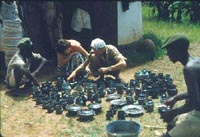
6. The same day that we arrived we saw our first kiln opening.
Very exciting. One of many that we were to see. In the middle of
this kiln opening, a big snake appeared and everybody went berserk,
all showing off and throwing rocks and carrying on, really just
showing off, until it was finally killed. Ladi came up and patted
Diane's arm as if to say, 'There, there, we'll look after you'.
|
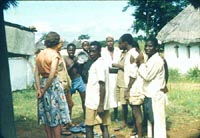
7. The same kiln opening. Cardew very happy with the results.
|
|

8. The back of the kiln shed with the woodpile ready to be chopped
up for firing. Michael used to send some of the boys up into the
hills about three miles away to dig clay and then he would get...
|
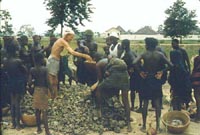
9. ... Gwari women (local tribe) to carry the clay back in calabashes,
paying them either ten pence or a shilling, depending on the size
of the calabash. Here he is, dispensing the money.
|
|
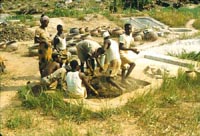
10. The clay mixing process went very smoothly. The clay was
ball milled in its right proportions and then the slip was poured
into the big, locally made pots at the back of the pottery, left
to stiffen, dug out and treaded, then kneaded and stored to increase
plasticity. Michael sourced Kaolin from tin mines on the Jos Plateau
to the north of Abuja.
|

11. Here is Cardew with Seth and Diane at this big deposit of kaolin.
|
|

12. It was brought down to Abuja by truck, where it was washed
and sieved and settled and dried.
|
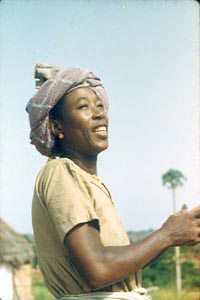
13. Here's Ladi, that brilliant person, that magical woman who Cardew
bought into the limelight, making one of her glorious pots. What
a wonderful idea. She made this pot outside especially for me to
photograph the process and was quite sulky afterwards for some reason,
until I found out that I hadn't given her a 'dash' but then she
was quite happy when I remedied that!
|
|

14. Ladi Starting the pot.
|

15. Base completed, adding coils.
|
|
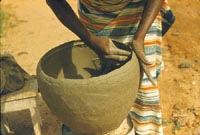
16. Welding in a coil, moving around the pot as in a wassa or
dance, singing.
|

17. Smoothing the rim with a strip of wet leather.
|
|

18. The finished pot, partly decorated.
|

19. Her simple tools - pieces of calabash, bamboo decorating tools,
leather and roulettes for decoration.
|
|
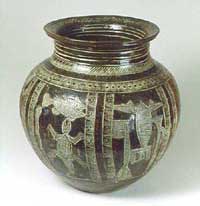
20. One of two Ladi pots, which Michael generously let us buy.
|

21. The second one was decorated with fish. At the pottery for three
months was a youngish woman from Argungu, near Sokoto. Here a fishing
festival was held each year. Ladi was inspired by the story of the
festival.
|
|
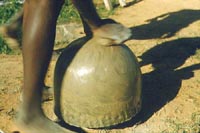
22. Ibrahim making a planter for roses for a friend of Michael.
Stretching a disc of clay over and upturned pot dusted with ash.
|

23. Adding a foot ring.
|
|

24. Adding a rim to the leather hard pot.
|

25. Dan Juma stacking oval dishes in the kiln - a dry season activity.
|
|
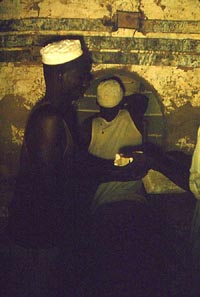
26. Loading the big kiln.
|

27. The 'Bourry' firebox.
|
|

28. My pots from the first kiln in which mine were glost fired.
|

29. When this raw glazed teapot of mine came out of this kiln, Michael
grabbed it, turning it around in his hands and saying, 'This is
a pot! This is a pot!' Later he asked Diane if he could buy it.
This was out of the question and we were delighted to give it to
him. He wrote about it from Abuja two or three times, saying it
had produced many progeny!
|

